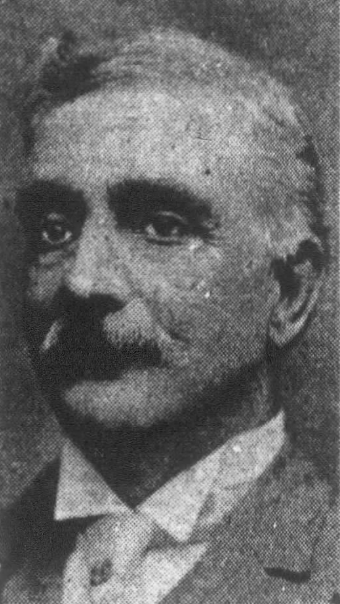Henry Vroom Hoagland
Henry Vroom Hoagland was born on November 2, 1842, in Somerville, New Jersey, to William V. F. Hoagland and Sarah P. Beekman. His parents baptized him in a Dutch Reformed Church in Bedminster, New Jersey. He grew up and attended school in New Jersey, and the family moved to Macoupin County, Illinois, around 1856.
He enlisted in the Union army on July 22, 1861, and he mustered in as a corporal in Company F of the 7th Illinois Infantry three days later. According to his service records, he was 5 feet, 8 inches tall, with dark hair and dark eyes. The regiment took part in the Battle of Fort Henry, the Battle of Fort Donelson, the Battle of Shiloh, and the siege of Corinth. He was promoted to sergeant in 1863, and he mustered out on July 9, 1865.
Hoagland remained devoted to the Union cause, writing that America’s “forefathers” had created “the purest laws and…the best goverment on the face of the earth.” Union victory, he added, would prove that “a goverment founded on the principles of human equality can stand and preserve its honor, even through greater perils than ever threatened any nation.” He also denounced the “abominable curse, human slavery, which has thretened to plunge us into disgrace and ruin.” In January 1865, he celebrated the impending Confederate downfall, writing that “their concentrated strength is now nearly exhausted, and the deep, clear, broad and beautiful river of liberty will soon flow unchecked, bearing upon its bosom joy and gladness to hundreds of millions who shall come after us.”
Hoagland returned to Macoupin County after the war, and he married Marietta Randolph on February 5, 1867. They had at least four children: Casie, born around 1870; Frank, born around 1873; Albert, born around 1876; and Evelyn, born around 1878. They moved to Springfield, Illinois, in the late 1860s, and he earned a living as a carpenter. The family moved to Lincoln, Nebraska, in the 1870s. By 1900, he was serving as the town’s chief of police. He also served as sheriff of Lancaster County, and he served two terms in the Nebraska legislature in the 1910s. He played an active role in the Grand Army of the Republic (GAR), serving as commander of the Nebraska GAR in the late 1920s. He died in Lincoln on February 14, 1930.
Image: Henry Vroom Hoagland (The Nebraska State Journal, 15 February 1930)
DATABASE CONTENT
| (3329) | Hoagland, Henry Vroom | 1842-11-02 | 1930-02-14 |
- Conflict Side: Union
- Role: Soldier
- Rank in: Private
- Rank out: Sergeant
- Rank highest: Sergeant
- Gender: Male
- Race: White
Documents - Records: 30
- (8988) [writer] ~ Henry V. Hoagland to Marietta Randolph, 5 April 1864
- (8989) [writer] ~ Henry V. Hoagland to Marietta Randolph, 25 March 1864
- (8990) [writer] ~ Henry V. Hoagland to Marietta Randolph, 19 December 1863
- (8991) [writer] ~ Henry V. Hoagland to Marietta Randolph, 24 September 1863
- (8992) [writer] ~ Henry V. Hoagland to Marietta Randolph, 10 May 1863
- (8993) [writer] ~ Henry V. Hoagland to Marietta Randolph, 27 April 186X
- (8994) [writer] ~ Henry V. Hoagland to Friend, 18 July 1862
- (9069) [writer] ~ Henry V. Hoagland to Marietta Randolph, 27 April 1865
- (9070) [writer] ~ Henry V. Hoagland to Marietta Randolph, 31 May 1865
- (9072) [writer] ~ Henry V. Hoagland to Marietta Randolph, 26 May 1865
- (9073) [writer] ~ Henry V. Hoagland to Marietta Randolph, 12 June 1865
- (9074) [writer] ~ Henry V. Hoagland to Marietta Randolph, 15 June 1865
- (9075) [writer] ~ Henry V. Hoagland to Marietta Randolph, 5 July 1865
- (9076) [writer] ~ Henry V. Hoagland, "True Story of the War," 1918
- (9077) [writer] ~ Henry V. Hoagland, "On Picket Duty," undated
- (9078) [writer] ~ "Story of Allatoona Pass," undated
- (10700) [writer] ~ Henry V. Hoagland to Marietta Randolph, 25 October 186X
- (10701) [writer] ~ Henry V. Hoagland to Marietta Randolph, undated
- (10702) [writer] ~ Henry V. Hoagland to Marietta Randolph, 12 June 1864
- (10703) [writer] ~ Henry V. Hoagland to Marietta Randolph, 19 June 1864
- (10704) [writer] ~ Henry V. Hoagland to Marietta Randolph, 20 July 1864
- (10705) [writer] ~ Henry V. Hoagland to Marietta Randolph, 4 September 1864
- (10706) [writer] ~ Henry V. Hoagland to Marietta Randolph, 20 October 1864
- (10707) [writer] ~ Henry V. Hoagland to Unknown, 12 November 1864
- (10708) [writer] ~ Henry V. Hoagland to Marietta Randolph, 18 December 1864
- (11084) [writer] ~ Henry V. Hoagland to Marietta Randolph, 3 January 1865
- (11098) [writer] ~ Henry V. Hoagland to William V. F. Hoagland and Sarah Hoagland, 11 January 1865
- (11099) [writer] ~ Henry V. Hoagland to Marietta Randolph, 18 January 1865
- (11100) [writer] ~ Henry V. Hoagland to Marietta Randolph, 6 April 1865
- (11101) [writer] ~ Henry V. Hoagland to Marietta Randolph, 9 April 1865
People - Records: 3
Places - Records: 2
Regiments - Records: 1
- (933) [enlisted] [F] ~ 7th Illinois Infantry
Groups - Records: 1
- (6) [member/supporter] ~ Grand Army of the Republic
SOURCES
1860, 1870, 1880, 1900, 1910, and 1920 United States Federal Censuses, available from Ancestry.com; Dutch Reformed Church Records in Selected States, 1639-1989, available from Ancestry.com; Civil War Soldier Records and Profiles, 1861-1865, available from Ancestry.com; Databases of Illinois Veterans Index, 1775-1995, available from Ancestry.com; Illinois Marriage Index, 1860-1920, available from Ancestry.com; Henry V. Hoagland to Marietta Randolph, 3 January 1865, DL1532.017, Nau Collection.





